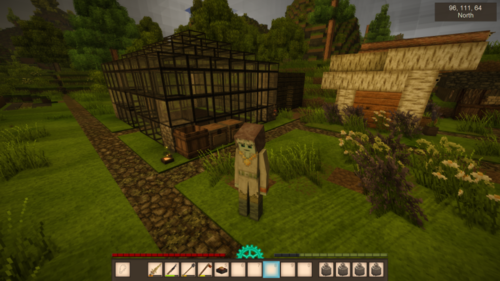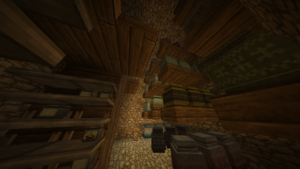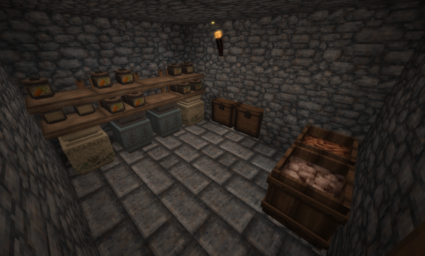Room: Difference between revisions
(Updating with a bit more information on the benefits of being inside a room on body temperature.) |
(Adding a couple more tips, fixing a slight error in information.) |
||
| Line 9: | Line 9: | ||
==== Cooling Score ==== | ==== Cooling Score ==== | ||
Any blocks may be used to create a room, but different blocks have different insulation values. Blocks in the stone, soil, ceramic, or ore classes are the best insulators, and will each add 1 to the cooling block total. The one exception being farmland which gives 3 to the non-cooling block total, as do trapdoors. Airtight doors add | Any blocks may be used to create a room, but different blocks have different insulation values. Blocks in the stone, soil, ceramic, or ore classes are the best insulators, and will each add 1 to the cooling block total. The one exception being farmland which gives 3 to the non-cooling block total, as do trapdoors. Airtight doors add 3 per block of space they occupy when open and 1 per block when closed to the non-cooling block total. The game creates the cooling score by dividing the non-cooling block total by the cooling block total and capping the number at 1, for 100%. | ||
==== Skylight Score ==== | ==== Skylight Score ==== | ||
| Line 15: | Line 15: | ||
{{Protip|You’ll tend to want at least 50% of the blocks making up your ceiling to allow sunlight through if you want a skylight score of 50% or more. Player-created light sources, such as torches and lanterns, have no impact on skylight score.}} | {{Protip|You’ll tend to want at least 50% of the blocks making up your ceiling to allow sunlight through if you want a skylight score of 50% or more. Player-created light sources, such as torches and lanterns, have no impact on skylight score.}} | ||
==== Creation ==== | ==== Creation ==== | ||
Any fully-enclosed space that fits within a 14x14x14 cube in size may be counted as a room by the game. All sides must be enclosed with full sides of blocks facing inwards, and all doors, including trapdoors, count as solid blocks for the sake of building a room with the exceptions of crude, sleek, and rough doors which all count as non-airtight doors. The one exception to the general rule is that chiseled blocks do not have to have a completely solid face, and instead have to have no more than 20 voxels missing from the inward face and at least 50% of the total volume of the block in voxels to count. | Any fully-enclosed space that fits within a 14x14x14 cube in size may be counted as a room by the game. All sides must be enclosed with full sides of blocks facing inwards, and all doors, including trapdoors, count as solid blocks for the sake of building a room with the exceptions of crude, sleek, and rough doors which all count as non-airtight doors. The one exception to the general rule is that chiseled blocks do not have to have a completely solid face, and instead have to have no more than 20 voxels missing from the inward face and at least 50% of the total volume of the block in voxels to count. | ||
{{Protip|You can use the /debug rooms hi command to check if the room you’re standing in counts as a valid room. If it highlights green you did it correctly and it will count as an enclosed room, if it highlights red something is wrong and it doesn’t see a room. Use /debug rooms unhi to remove the highlighting!}} | |||
== Greenhouse == | == Greenhouse == | ||
[[File:greenhouse.png|float|right|500px]] | [[File:greenhouse.png|float|right|500px]] | ||
| Line 52: | Line 52: | ||
Cellars can also used to ripen cheese by lowering its spoilage timer, so that the cheese can ripen. Cheese can only ripen when placed onto a shelf with a perish rate of 0.5x or lower. Cheddar does not have to be made in a cellar and can be made outside if it is cold enough, while blue cheese must be made in a special kind of open-air cellar that doesn’t count as a room for any other purpose with at least one open exit ''and'' a sunlight level below 2. Blue cheese does also still need to be ripened when the perish rate is 0.5x or lower, however, but an open-air cellar does not count as a proper room, and so blue cheese ripening can only be done when it is cold enough outside to lower the perish rate to the necessary level. | Cellars can also used to ripen cheese by lowering its spoilage timer, so that the cheese can ripen. Cheese can only ripen when placed onto a shelf with a perish rate of 0.5x or lower. Cheddar does not have to be made in a cellar and can be made outside if it is cold enough, while blue cheese must be made in a special kind of open-air cellar that doesn’t count as a room for any other purpose with at least one open exit ''and'' a sunlight level below 2. Blue cheese does also still need to be ripened when the perish rate is 0.5x or lower, however, but an open-air cellar does not count as a proper room, and so blue cheese ripening can only be done when it is cold enough outside to lower the perish rate to the necessary level. | ||
{{Protip|Remember if you’re trying to build an open-air cellar to ripen blue cheese in that /debug rooms hi will always show those as red, but you can fill in the hole before using the command to check and make sure that it counts as a room, and then dig out the hole to make it open-air again.}} | |||
{{Farming navbox}} | {{Farming navbox}} | ||
[[Category:Structures{{#translation:}}]] | [[Category:Structures{{#translation:}}]] | ||
Revision as of 00:33, 23 March 2024
This page was last verified for Vintage Story version 1.19.5.
Rooms are a type of structure players may create for staying warm and avoiding the consequences of harsh winter, or to use as cellars or greenhouses.
The game checks through each block in a room to determine the sunlight level of each of the blocks inside the room and the coolness level of each of the blocks making up the walls, floor, and ceiling of the room. If it determines there are no open exits it will classify it as an enclosed room. All valid rooms are enclosed rooms with the one exception of open-air cellars for making blue cheese.
If you are in a fully enclosed room the increased hunger rate of harsh winter will be removed. Additionally if the room has a skylight score of less than 50% the heat you gain from being near a heat source extends farther out into the room, you are protected from the wind reducing your temperature, and while sleeping your temperature will slowly adjust towards normal.
Cooling Score
Any blocks may be used to create a room, but different blocks have different insulation values. Blocks in the stone, soil, ceramic, or ore classes are the best insulators, and will each add 1 to the cooling block total. The one exception being farmland which gives 3 to the non-cooling block total, as do trapdoors. Airtight doors add 3 per block of space they occupy when open and 1 per block when closed to the non-cooling block total. The game creates the cooling score by dividing the non-cooling block total by the cooling block total and capping the number at 1, for 100%.
Skylight Score
Any blocks inside the room that have at least as much sunlight as outside the room will count toward the skylight count. The total skylight score is determined by dividing the skylight count by the total volume of blocks inside the room.
Protip:
You’ll tend to want at least 50% of the blocks making up your ceiling to allow sunlight through if you want a skylight score of 50% or more. Player-created light sources, such as torches and lanterns, have no impact on skylight score. |
Creation
Any fully-enclosed space that fits within a 14x14x14 cube in size may be counted as a room by the game. All sides must be enclosed with full sides of blocks facing inwards, and all doors, including trapdoors, count as solid blocks for the sake of building a room with the exceptions of crude, sleek, and rough doors which all count as non-airtight doors. The one exception to the general rule is that chiseled blocks do not have to have a completely solid face, and instead have to have no more than 20 voxels missing from the inward face and at least 50% of the total volume of the block in voxels to count.
Protip:
You can use the /debug rooms hi command to check if the room you’re standing in counts as a valid room. If it highlights green you did it correctly and it will count as an enclosed room, if it highlights red something is wrong and it doesn’t see a room. Use /debug rooms unhi to remove the highlighting! |
Greenhouse
Greenhouses are structures intended to make farming crops possible in climates that drop below the pausing point of crops for part of the year. If built correctly, the farmland, fruit trees, berries, or beehives inside of the structure will show an additional line for the effect of "+5°C". Which means that these blocks will be 5°C warmer than those outside at all times.
Creation
Greenhouses require a skylight score of at least 50%, meaning it’s impossible to build one completely covered underground. Remember that if you dig one down it will still incur the underground farming penalty if that is turned on, no matter how much sunlight it gets. And finally when determining how big to make a greenhouse remember that if you want to put water in holes between farmland you have to count that as part of the height of the 14x14x14 cube or the game will think the area is too large and stop classifying it as a room. You can save room by hiding the water source blocks under outside walls of the greenhouse as well.
Protip:
It might take a little bit of time before the +5°C buff appears on the blocks inside of the structure, and not all blocks will be updated simultaneously. To be precise, every block checks if it’s in a greenhouse after a maximum of 4 ingame hours, give or take a few seconds. |
Cellar
Cellars are used to store any goods that will spoil at a much slower spoil rate than would normally be had outside or in a larger room.
Creation
When detecting a room the game will make extra checks to see if the room is small enough to be a cellar. Normally this is anything within a 7x7x7 cube, but it is possible to build up to 9 blocks wide in a single direction so long as the total volume of all the blocks inside the cellar is no more than 150.
Cellars do not need to be underground to work, however since sunlight levels can affect cellar effectiveness, it may be easier to dig an underground cellar than to create an above-ground one.
Food Preservation
The main use of cellars is for food preservation, however cellars reduce the rate of spoilage for any good stored inside whether it is a food or not, and stack with container types, so placing storage vessels and sealed crocks into a cellar can drastically extend the shelf-life of any food inside them.
When calculating how fast food will spoil in a cellar the game first creates a cellar weight score for the room of 100% and then it takes away as much as 40% of the weight depending on the skylight score, and as much as 50% of the weight depending on the cooling score.
The air temperature inside the cellar will never be greater than the air temperature outside. When the weight of the cellar is 100% the air temperature with cap at 5ºC, otherwise the game will calculate air temperature based on the weight and skylight score, in addition to how much sunlight is in the container block being calculated.
Protip:
Because there is no minimum size for a cellar, burying a vessel in a cube of dirt is an extremely effective way of preserving food early-game. Just dig out the top block or a side block to access it, then replace it to seal it again. Note: Make sure the vessel is surrounded on every side by a cooling block and never build with anything transparent or you won’t get the full bonus! |
Cheese Ripening
Cellars can also used to ripen cheese by lowering its spoilage timer, so that the cheese can ripen. Cheese can only ripen when placed onto a shelf with a perish rate of 0.5x or lower. Cheddar does not have to be made in a cellar and can be made outside if it is cold enough, while blue cheese must be made in a special kind of open-air cellar that doesn’t count as a room for any other purpose with at least one open exit and a sunlight level below 2. Blue cheese does also still need to be ripened when the perish rate is 0.5x or lower, however, but an open-air cellar does not count as a proper room, and so blue cheese ripening can only be done when it is cold enough outside to lower the perish rate to the necessary level.
Protip:
Remember if you’re trying to build an open-air cellar to ripen blue cheese in that /debug rooms hi will always show those as red, but you can fill in the hole before using the command to check and make sure that it counts as a room, and then dig out the hole to make it open-air again. |
| Farming | |
|---|---|
| Wild foods | Berries • Cactus (saguaro) fruit • Mushrooms • Cattail (and papyrus) |
| Grains | Amaranth • Cassava • Flax • Rice • Rye • Spelt • Sunflower |
| Vegetables | Cabbage • Carrot • Onion • Turnip • Parsnip • Peanut • Pumpkin • Soybean |
| Fruits | Fruit trees • Pineapple |
| Other | Fertilizer • Beekeeping • Room |
| Tools | Hoe • Scythe • Fruit press |
| See also | Animal husbandry • Cooking • Food preservation |



